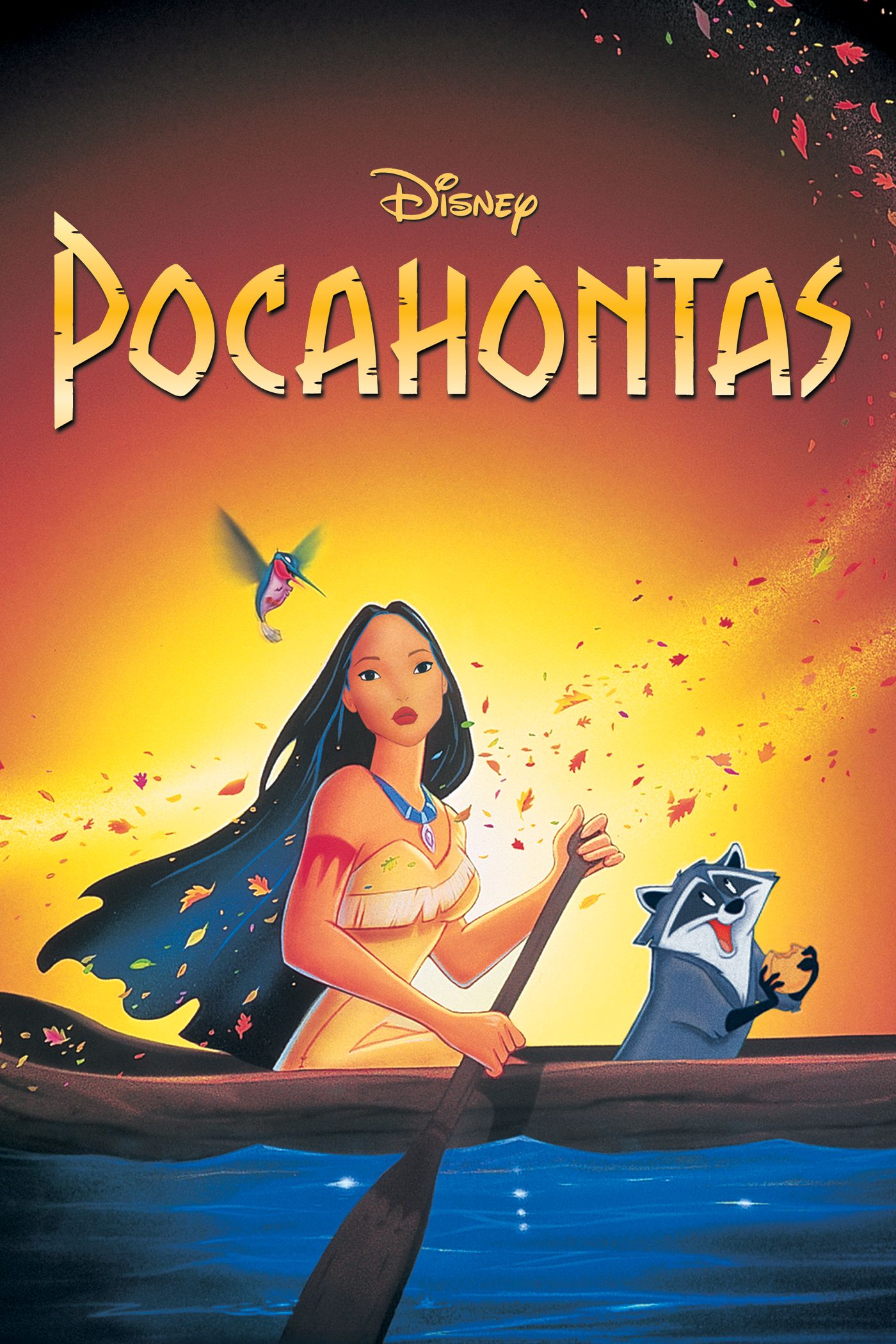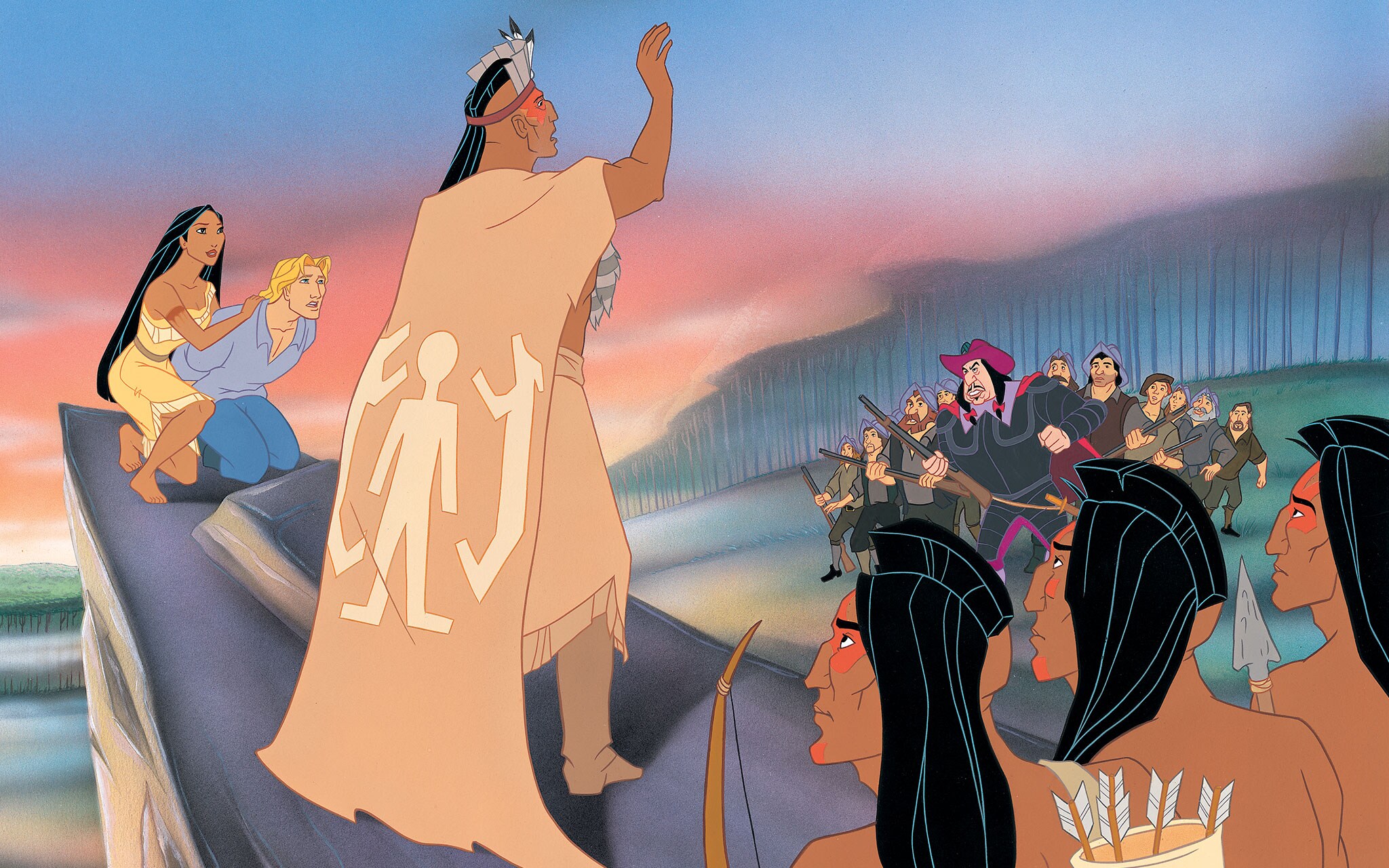Pocahontas (1995): "Sometimes the right path is not the easiest one"
In 1607, the Susan Constant sails from London to the New World, carrying English settlers from the Virginia Company. Along the way, the Susan Constant is caught in a North Atlantic storm and Captain John Smith, who dreams about adventure, saves Thomas, a young and inexperienced crewmate, from drowning. Annnd here we go with introducing the typical male heroine. As they approach the New World, the settlers, including John, talk of adventure, finding gold, fighting "Injuns" and potentially settling in the new land. This part seems somewhat accurate, at least on a sugarcoated note.
In the Powhatan tribe, Pocahontas, the beautiful daughter of Chief Powhatan, fears being possibly wed to Kocoum, a brave warrior whom she sees as too serious for her own free-spirited personality (if you've seen this movie, too, it is understandable why she feels this way). The Chief gives Pocahontas her mother's necklace as a present which she cherishes greatly. Pocahontas, along with her friends, the raccoon Meeko and hummingbird Flit, visit Grandmother Willow, a spiritual talking willow tree. I wish I were friends with animals and a talking willow tree. Pocahontas speaks of a dream involving a spinning arrow and her confusion regarding what her path in life should be. Grandmother Willow then alerts Pocahontas to the arriving English and hurries her to be careful.
The voyage's greedy leader Governor Ratcliffe, who seeks gold as part of his plan to bring him wealth and status, has Jamestown built in a wooded clearing and immediately has the crewmen dig for gold. Ugh, you will see later on that he is one of the worst Disney villains. John Smith departs to explore the wilderness and encounters Pocahontas. At first, he cannot hear her speak English (of course, this makes sense due to the language barrier), but Grandmother Willow gives him the ability to hear her speak English. Ah, yes, we love to see some confusing Disney magic occur out of nowhere.The two quickly bond, fascinated by each other's worlds, and end up falling in love, despite Powhatan's orders to stay away from the Englishmen after Kocoum and the other warriors engage them in a fight. This part is pretty inaccurate, as I believe that she did not fall in love with John Smith but with another man. I will have to brush up on my history, so please feel free to correct me!
Meanwhile, Meeko the racoon meets Percy, Ratcliffe's pet pug, and becomes the bane of his existence (literally). When John tells Pocahontas that his men and he are here to find gold, she tells him that there is no gold, much to his disappointment. Pocahontas introduces John to Grandmother Willow and avoids other crewmen, Ben and Lon, who are searching for him. Unfortunately, though, Pocahontas's best friend, Nakoma, discovers her romantic relationship with John and warns Kocoum, the man who is supposed to marry Pocahontas. Ratcliffe also learns of John's encounters with Pocahontas and angrily warns John against sparing any natives he comes across as treason.
Later, John and Pocahontas meet with Grandmother Willow and plan to bring peace between the colonists and the tribe (if only it were that easy, honestly and realistically). John and Pocahontas share a kiss, while Kocoum and Thomas, sent by both parties to spy on each other, witness from afar. Outraged, Kocoum attacks and attempts to kill John, but Thomas intervenes shooting and killing Kocoum, who pulls on Pocahontas's necklace as he collapses, destroying it. John orders Thomas to leave before the tribesmen arrive, capture John, and retrieve Kocoum's body. Enraged at Kocoum's death, the Chief angrily berates Pocahontas for leaving the village and declares war on the English, beginning with John's execution at dawn.Thomas reaches Jamestown safely at night and warns the English settlers of John's capture. Ratcliffe then rallies his men to battle, using this as an excuse to annihilate the tribe and find their (nonexistent) gold. That same night, the Chief also orders his men to prepare for battle. Annnd another song commences, just showing how Disney likes to sugarcoat history. A desperate Pocahontas visits Grandmother Willow, where Meeko the racoon hands her John's compass. Pocahontas realizes the arrow from John's compass is the same spinning arrow from her dream, which leads to her destiny and answering her question from the beginning.
Morning comes, and the Chief and his tribe drag John to a cliff overlooking a clearing for execution. Meanwhile, Ratcliffe leads the armed colonists to the cliff to fight the Chief's warriors. Just as the Chief is about to execute John, Pocahontas intervenes by placing herself over John's body and finally convinces her father to end the fighting between the two groups and spare John's life. Both sides stand down, and John is released, but when the unmoved and enraged Ratcliffe orders his men to attack, they refuse. Due to Ratcliffe's betrayal, he fires his musket at the Chief, but John takes the shot himself and is injured. Livid, the settlers turn on Ratcliffe and detain him for hurting their comrade.While in reality John probably would have died to the gunshot wound and the medicine back then was not as good, John is miraculously nursed back to health by the tribe but must return to England for his wounds to fully heal. Ratcliffe is also sent back to England to face punishment for his crimes against the settlement. John asks Pocahontas to come with him, but she chooses to stay with her tribe to help keep the peace. Meeko and Percy, then enemies but now friends, give Pocahontas her mother's necklace, completely fixed. John leaves without Pocahontas, but with the Chief's blessing to return anytime he likes. The film ends with Pocahontas standing atop a cliff, watching the ship carrying John depart. A perfect ending to this musically, historically inaccurate, and dramatic Disney film.
Don't believe me in how inaccurate this film is (or you are interested in history through the eyes of a musical)? Watch it for yourself, and you will see how this movie plays out. As said before, Pocahontas was praised for the voice actors, beautiful animation, and great songs, but the plotline...not so much.




I absolutely loved this post about Pocahontas. This was definitely one of my favorite movies growing up. I think as children, we never realize the plot line of anything, and it took me years to put this movie into context. I still consider it a beautiful movie because the animation is done flawlessly and the musical aspect of it is gorgeous! Amazing blog!
ReplyDelete